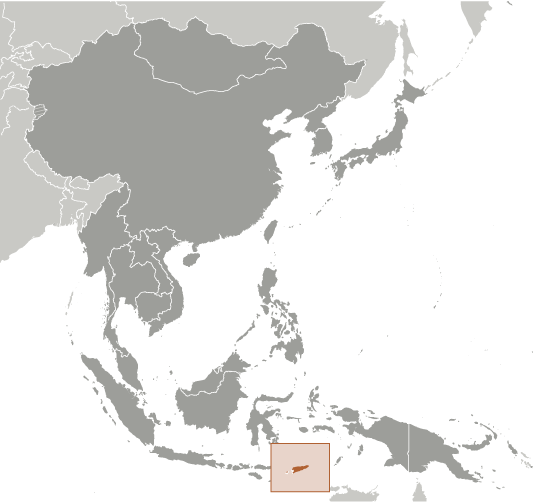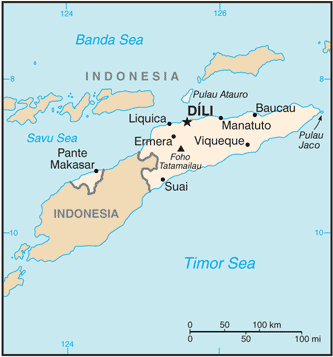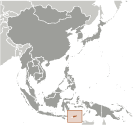
|
|
Advertisements:
EconomyEconomy - overview
In late 1999, about 70% of the economic infrastructure of Timor-Leste was laid waste by Indonesian troops and anti-independence militias. Three hundred thousand people fled westward. Over the next three years a massive international program, manned by 5,000 peacekeepers (8,000 at peak) and 1,300 police officers, led to substantial reconstruction in both urban and rural areas. The country continues to face great challenges in rebuilding its infrastructure, strengthening the civil administration, and generating jobs for young people entering the work force. The development of oil and gas resources in offshore waters has greatly supplemented government revenues. This technology-intensive industry, however, has done little to create jobs for the unemployed in part because there are no production facilities in Timor-Leste. Gas is piped to Australia. In June 2005, the National Parliament unanimously approved the creation of a Petroleum Fund to serve as a repository for all petroleum revenues and to preserve the value of Timor-Leste's petroleum wealth for future generations. The Fund held assets of US$9.3 billion as of December 2011. The economy continues to recover strongly from the mid-2006 outbreak of violence and civil unrest, which disrupted both private and public sector economic activity. All of the estimated 100,000 internally displaced persons returned home by early 2009. Government spending increased markedly from 2009 through 2011, primarily on basic infrastructure, including electricity and roads. Limited experience in procurement and infrastructure building has hampered these projects. The underlying economic policy challenge the country faces remains how best to use oil-and-gas wealth to lift the non-oil economy onto a higher growth path and to reduce poverty. The parliament in late 2011 approved an ambitious, infrastructure-focused $1.67 billion budget for 2012 that would allow the government to borrow for the first time in its 10-year history. Gdp (purchasing power parity) World Ranking: 153
$9.629 billion (2011 est.)
$8.707 billion (2010 est.) $7.953 billion (2009 est.) Note Data are in 2011 US dollars Gdp (official exchange rate)
$4.315 billion
Note Non-oil GDP (2011 est.) Gdp - real growth rate World Ranking: 5
10.6% (2011 est.)
9.5% (2010 est.) 12.8% (2009 est.) Gdp - per capita (ppp) World Ranking: 119
$8,800 (2011 est.)
$8,200 (2010 est.) $7,600 (2009 est.) Note Data are in 2011 US dollars Gdp - composition by sector
Agriculture 26.5%
Industry 17.8% Services 55.6% (2011 est.) Labor force World Ranking: 158
418,200 (2009)
Labor force - by occupation
Agriculture 64%
Industry 10% Services 26% (2010) Unemployment rate World Ranking: 159
18.4% (2010 est.)
20% (2006 est.) Population below poverty line
41% (2009 est.)
Household income or consumption by percentage share
Lowest 10% 4%
Highest 10% 27% (2007) Distribution of family income - gini index World Ranking: 106
31.9 (2007 est.)
38 (2002 est.) Budget
Revenues $2.6 billion
Expenditures $1.3 billion (2011 est.) Taxes and other revenues World Ranking: 9
60.3% of GDP (2011 est.)
Budget surplus (+) or deficit (-) World Ranking: 2
30.1% of GDP (2011 est.)
Inflation rate (consumer prices) World Ranking: 199
12.3% (2011 est.)
6.8% (2010 est.) Commercial bank prime lending rate World Ranking: 78
11.04% (31 December 2011 est.)
11% (31 December 2010 est.) Stock of narrow money World Ranking: 180
$162.7 million (31 December 2011 est.) $141.4 million (31 December 2010 est.) Stock of broad money World Ranking: 184
$322.4 million (31 December 2011 est.) $295 million (31 December 2010 est.) Stock of domestic credit World Ranking: 178
$280 million (31 December 2011 est.) $221 million (31 December 2010 est.) Market value of publicly traded shares
$NA
Agriculture - products
Coffee, rice, corn, cassava (manioc), sweet potatoes, soybeans, cabbage, mangoes, bananas, vanilla Industries
Printing, soap manufacturing, handicrafts, woven cloth Industrial production growth rate World Ranking: 23
8.5% (2004 est.)
Electricity - production World Ranking: 186
131.7 million kWh (2011 est.)
Electricity - consumption World Ranking: 198
67.59 million kWh (2011 est.)
Electricity - exports
0 kWh (2011 est.)
Electricity - imports
0 kWh (2011 est.)
Oil - production World Ranking: 51
87,500 bbl/day (2010 est.)
Oil - consumption World Ranking: 182
2,600 bbl/day (2010 est.)
Oil - exports World Ranking: 66
86,000 bbl/day (2009 est.)
Oil - proved reserves World Ranking: 48
553.8 million bbl (1 January 2011 est.) Natural gas - production World Ranking: 134
0 cu m (2009 est.)
Natural gas - consumption World Ranking: 136
0 cu m (2009 est.)
Natural gas - exports World Ranking: 194
0 cu m (2009 est.)
Natural gas - imports World Ranking: 133
0 cu m (2009 est.)
Natural gas - proved reserves World Ranking: 45
200 billion cu m (1 January 2006 est.) Current account balance World Ranking: 39
$2.375 billion (2011 est.)
$1.161 billion (2007 est.) Exports World Ranking: 208
$18 million (2011 est.)
$17.8 million (2010 est.) Note Excludes oil Exports - commodities
Oil, coffee, sandalwood, marble Note Potential for vanilla exportsImports World Ranking: 186
$689 million (2011 est.)
$439.1 million (2010 est.) Imports - commodities
Food, gasoline, kerosene, machinery Exchange rates
The US dollar is used
Fiscal year
Calendar year
Comments
Add a new comment: |
Advertisement
Members area
East Timor:
 
GPS points from East Timor
|
||||||||

 The Portuguese began to trade with the island of Timor in the early 16th century and colonized it in mid-century. Skirmishing with the Dutch in the region eventually resulted in an 1859 treaty in which Portugal ceded the western portion of the island. Imperial Japan occupied Portuguese Timor from 1942 to 1945, but Portugal resumed colonial authority after the Japanese defeat in World War II. East Timor declared itself independent from Portugal on 28 November 1975 and was invaded and occupied by Indonesian forces nine days later. It was incorporated into Indonesia in July 1976 as the province of Timor Timur (East Timor). An unsuccessful campaign of pacification followed over the next two decades, during which an estimated 100,000 to 250,000 individuals lost their lives. On 30 August 1999, in a UN-supervised popular referendum, an overwhelming majority of the people of Timor-Leste voted for independence from Indonesia. However, in the next three weeks, anti-independence Timorese militias - organized and supported by the Indonesian military - commenced a large-scale, scorched-earth campaign of retribution. The militias killed approximately 1,400 Timorese and forcibly pushed 300,000 people into western Timor as refugees. Most of the country's infrastructure, including homes, irrigation systems, water supply systems, and schools, and nearly 100% of the country's electrical grid were destroyed. On 20 September 1999, Australian-led peacekeeping troops deployed to the country and brought the violence to an end. On 20 May 2002, Timor-Leste was internationally recognized as an independent state. In 2006, internal tensions threatened the new nation's security when a military strike led to violence and a breakdown of law and order. At Dili's request, an Australian-led International Stabilization Force (ISF) deployed to Timor-Leste, and the UN Security Council established the UN Integrated Mission in Timor-Leste (UNMIT), which included an authorized police presence of over 1,600 personnel. The ISF and UNMIT restored stability, allowing for presidential and parliamentary elections in 2007 in a largely peaceful atmosphere. In February 2008, a rebel group staged an unsuccessful attack against the president and prime minister. The ringleader was killed in the attack and most of the rebels surrendered in April 2008. Since the unsuccessful attacks the government has enjoyed one of its longest periods of post-independence stability.
The Portuguese began to trade with the island of Timor in the early 16th century and colonized it in mid-century. Skirmishing with the Dutch in the region eventually resulted in an 1859 treaty in which Portugal ceded the western portion of the island. Imperial Japan occupied Portuguese Timor from 1942 to 1945, but Portugal resumed colonial authority after the Japanese defeat in World War II. East Timor declared itself independent from Portugal on 28 November 1975 and was invaded and occupied by Indonesian forces nine days later. It was incorporated into Indonesia in July 1976 as the province of Timor Timur (East Timor). An unsuccessful campaign of pacification followed over the next two decades, during which an estimated 100,000 to 250,000 individuals lost their lives. On 30 August 1999, in a UN-supervised popular referendum, an overwhelming majority of the people of Timor-Leste voted for independence from Indonesia. However, in the next three weeks, anti-independence Timorese militias - organized and supported by the Indonesian military - commenced a large-scale, scorched-earth campaign of retribution. The militias killed approximately 1,400 Timorese and forcibly pushed 300,000 people into western Timor as refugees. Most of the country's infrastructure, including homes, irrigation systems, water supply systems, and schools, and nearly 100% of the country's electrical grid were destroyed. On 20 September 1999, Australian-led peacekeeping troops deployed to the country and brought the violence to an end. On 20 May 2002, Timor-Leste was internationally recognized as an independent state. In 2006, internal tensions threatened the new nation's security when a military strike led to violence and a breakdown of law and order. At Dili's request, an Australian-led International Stabilization Force (ISF) deployed to Timor-Leste, and the UN Security Council established the UN Integrated Mission in Timor-Leste (UNMIT), which included an authorized police presence of over 1,600 personnel. The ISF and UNMIT restored stability, allowing for presidential and parliamentary elections in 2007 in a largely peaceful atmosphere. In February 2008, a rebel group staged an unsuccessful attack against the president and prime minister. The ringleader was killed in the attack and most of the rebels surrendered in April 2008. Since the unsuccessful attacks the government has enjoyed one of its longest periods of post-independence stability.